With hockey at a standstill and the draft year seemingly done, there are twice as many questions as facts now that the season has been cut short. Here are 10 burning questions for the 2020 NHL Draft — ranging from individuals to positions to countries.
RELATED: 5 Presumed Facts for 2020 NHL Draft
1) Does Quinton Byfield go second overall?
The consensus is yes, but I am not convinced. It may depend on the team — once the order is decided following the draft lottery — but I could see Tim Stutzle, Lucas Raymond or even Jamie Drysdale stealing that spot from Byfield. I don’t have Byfield as my second-ranked prospect — he is No. 4 for me, behind Raymond (2) and Stuzle (3), and just ahead of Drysdale (5) — but I know I am in the minority there. And those are rankings, not a mock draft in which I will likely still lean towards Byfield when making that prediction for second overall.
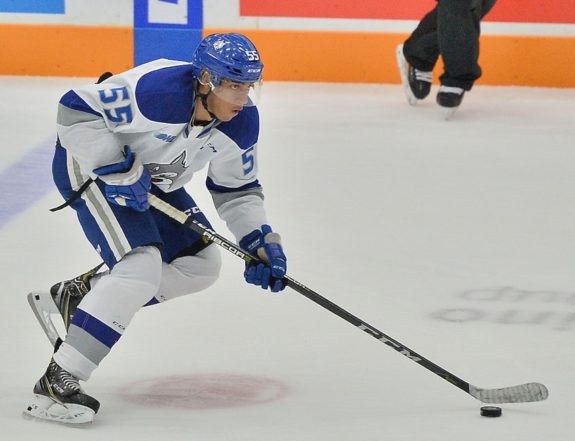
Byfield has huge upside as a No. 1 centre, with the physical tools to dominate men the same way he is dominating boys in the OHL. Byfield is also one of the younger prospects in this draft class with an August birthdate, implying he has plenty of development to come. However, Byfield has not shone on the best-on-best stages — ranging from the Hlinka Gretzky Cup to the World Juniors to the CHL Top Prospects Game — and those mediocre showings have raised question marks, if not red flags.
There has been chatter amongst NHL scouts and insiders that Byfield was losing his grip on second overall and had been slipping in the minds of some. Assuming the OHL playoffs are cancelled by coronavirus, Byfield won’t get a chance to restore his stock by taking Sudbury on a run. So will he go second overall? Probably, but Byfield is closer to going third overall than he is to challenging Alexis Lafreniere for first overall.
2) Who will be the second defenceman — and how high?
Jake Sanderson seems to be the leading candidate after starring at the Four Nations tournament — he was the best defender at that showcase and many are now projecting him to be the second defenceman after Drysdale. Sanderson is showing up in the top 15 for most of the recently published rankings — including mine, No. 15 for March — and some even have him rising into the top 10. That is possible but might also be a bit of recency bias.

Sanderson has made a strong case — and 2020 isn’t an overly strong year for defencemen — but he is far from a slam dunk. There are 12 defenders in my 21-53 tier that could still be taken ahead of Sanderson: Justin Barron (22), Emil Andrae (25), Lukas Cormier (26), Kaiden Guhle (27), Braden Schneider (28), Jeremie Poirier (29), Joni Jurmo (34), William Wallinder (35), Ryan O’Rourke (38), Topi Niemela (39), Eemil Viro (45) and Helge Grans (46). There are also a couple wild-cards in Shakir Mukhamadullin (63) and Anton Johannesson (69) that could be surprise picks as high as the teens. So that is 14 defencemen for NHL teams to consider since there is no consensus on that order and scouts will have them ranked wildly different. Some teams may even have these seven in their top 31: Tyler Kleven (62), Michael Benning (64), Samuel Knazko (68), Alexander Nikishin (81), Yan Kuznetsov (82), William Villeneuve (83) and Daemon Hunt (87).
I foresee all 23 of those defencemen — counting Drysdale and Sanderson — going in the top three rounds, plus the possibility of a few overagers in Alex Cotton (88), Axel Rindell (122) and Adam Wilsby (123). For my money, as of today, Sanderson will be the second defenceman taken in 2020 — somewhere in the 10-15 range.

The tougher question: who will be the top European defenceman? I would bet on one of the Swedes — Andrae, Wallinder, Grans and Johannesson — but I wouldn’t rule out the Finns in Jurmo, Niemela and Viro, or the enigmatic Russian in Mukhamadullin. I could see four of those eight ending up in the first round, even though Andrae is the only one in my top 31. So who will it be? I’ll say Grans.
3) Who will be the second goaltender — and how high?
Yaroslav Askarov is the only goalie generating hype for 2020 as a first-round prospect and potential top-10 pick. Beyond that, it is a guessing game for the order of goaltenders. The contenders to go second include Drew Commesso (75), Nick Malik (90), Joel Blomqvist (91), Jan Bednar (117) and Calle Clang (118) as well as overagers Nico Daws (89), Samuel Hlavaj (115) and Amir Miftakhov (116). It should be one of those eight, with the first three seeming like the best bets. I don’t have any of them in the second round of my rankings, but I will probably mock at least one of them in my top 62. If I have to single somebody out right now, I’ll say Blomqvist between 50 to 62.
Not all 31 teams will draft a goaltender — and very few will take more than one — but here are 15 other names to keep in mind for first-time eligibles: Dylan Garand (147), Vsevolod Skotnikov (173), Aidan Campbell (178), Devon Levi (211), Yegor Guskov (226), Artur Akhtyamov (227), Antoine Coulombe (245), Brock Gould (261), Garin Bjorklund (300), Jesper Vikman, Hugo Ollas, Brett Brochu, Fabio Iacobo, Owen Parker and Tucker Tynan providing he makes a full recovery from his gruesome injury. And here are 13 more overagers of note: Jakub Dobes (191), Victor Ostman (225), Lassi Lehtinen, Jere Huhtamaa, Vladimir Sartakov, Logan Stein, Cameron Rowe, Taylor Gauthier, Cole McLaren, Luca Hollenstein, Matthew Davis, Gabriel Carriere and Creed Jones. For those keeping count, that is 37 goaltenders with a realistic chance of getting drafted in 2020. Time will tell how many of them hear their names called.
4) How many Americans will go in the first round?
I have 17 Americans in my top 100 but only one in my top 31 — that being Sanderson (15). But will he be the lone American taken in the first round in 2020 after a record-setting nine in 2019? Of those 17, I believe eight others — in addition to Sanderson — have a hope of becoming first-round picks: Thomas Bordeleau (36), Sean Farrell (50), Brendan Brisson (51), Antonio Stranges (59), Ty Smilanic (60), Luke Tuch (61), Tyler Kleven (62) and Sam Colangelo (65). Some scouts may extend that group to 12, including Brett Berard (73), Blake Biondi (74), Dylan Peterson (80) and Brock Faber (96).
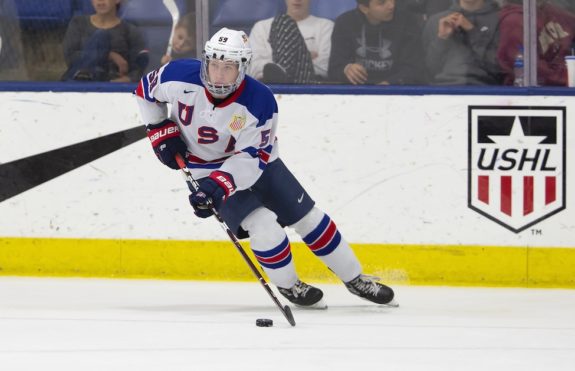
I have a feeling a few of them — three, to be exact, counting Sanderson — will be taken in the first round. In defence of my rankings, which are relatively low on the entire NTDP roster despite 13 players from The Program being in my top 150, I was anticipating some risers from that team coming out of the under-18 worlds where I typically focus on the Americans more than any other country. To be honest, that was a difficult team to scout, attempting to avoid direct comparisons to last year’s powerhouse but trying to rank them fairly among their 2020 peers. If two more Americans are joining Sanderson in the first round, NTDP forwards Smilanic and Tuch might be the best bets.
Rounding out my top 100 among Americans are NTDP goaltender Commesso (75) and three forwards in Landon Slaggert (97), Jack Smith (98) and Grant Slukynsky (99), with the latter two also qualifying for this next question.
5) Who will be the top high-schooler — and how high?
Biondi is the frontrunner as this year’s Mr. Hockey winner — awarded to the best high-schooler in Minnesota — but Smith, Slukynsky and fast-rising Joe Miller (218) are also forwards in the running from the State of Hockey. Minnesota has a few defencemen that could go much higher than I have them ranked in Jake Ratzlaff (184), Jake Boltmann (185) and Wyatt Kaiser (186), while Ian Moore (224) from Massachusetts is another blueliner to be aware of.
Any of those eight could crack the top 100 and perhaps go as high as the second round. I don’t anticipate any high-schoolers going in the first round in 2020, but I have been wrong on that front before. I tend to be way too low on the high-schoolers in general — largely due to limited viewings that result in a cautious approach for my rankings.
Take 2019, for example, when I had John Farinacci as the top high-schooler in my final rankings at No. 73 and he went 76th overall to Arizona but as the fourth high-schooler behind second-rounders Jackson LaCombe (39) and Jayden Struble (46) as well as Matthew Stienburg (63), who was the first pick of the third round. I had LaCombe (121) and Struble (120) ranked as fourth-rounders, with Stienburg (251) outside my draft range.
I am no expert on high-schoolers and don’t pretend to be, but I still try to rank the prospects that are recommended to me. For 2020, there are 20 high-schoolers that will likely crack my final rankings — my top 350 — and that list includes the Shattuck St. Mary’s forward trio of Artem Shlaine (195), Jackson Kunz (220) and Winter Wallace (221), plus fellow forwards Carsen Richels (196), Cole Hansen (219), Alex Jefferies (222), Aidan Thompson (223), Jackson Hallum, Blake Perbix, Riley Duran and last but not least Mark Hillier, who broke Morgan Barron’s scoring record at St. Andrew’s College — a Canadian high school program that also produced Stienburg. I may have been sleeping on Hillier, among others from that list.
Owen Parker is my top high school goaltender — a towering 6-foot-6 netminder and the son of Buffalo sports radio personality Chris Parker — and I might have to make room for four more Minnesota defenders in Luke Gramer, Mason Langenbrunner, Will Svenddal and Reid Bogenholm after they received rave reviews following The Tourney state championships from trusty scout Steve Kournianos (@TheDraftAnalyst). That would bring the total to 24 — up from 18 in my top 350 for 2019 — but Biondi will remain the betting favourite to be the top high-schooler in 2020. I could see a team taking Biondi in the top 50 — perhaps as high as 40.
6) How many defencemen will go in the top 20?
Another defence question — and there are a couple more to come — but this position is the most intriguing for 2020. It is also the toughest to predict. Nobody really knows what is going to happen with the defencemen beyond Drysdale. Rankings don’t necessarily reflect draft projections — that is what mocks are for — so I do anticipate more than two defencemen going in the top 20 despite only having Drysdale (5) and Sanderson (15) in my top 20.
I prefer the forwards in my 11-20 tier, but I wouldn’t be surprised to see a run of defencemen in the teens. I wouldn’t rule that out. Barron was pegged for the top 20 coming into the draft year and several teams will still be high on him. Guhle and Schneider have got a fair bit of top-20 love from mainstream sources with connected scouts, including TSN and Sportsnet. Poirier has been another popular top-20 candidate. Grans, Wallinder and Jurmo are big blueliners with similarities to 2019 top-10 pick Philip Broberg. Niemela and Viro are more like Ville Heinola, the 20th overall selection from 2019 who made the NHL out of camp this season (albeit out of necessity). Andrae and Johannesson are offensive Swedes in the mould of Erik Brannstrom, the 15th overall pick from 2017. Mukhamadullin has been a fixture in Craig Button’s first round, among others. Cormier and O’Rourke could conceivably be top 20 on some teams’ lists, which will vary greatly from the consolidated rankings. Kleven could be the shocker if a team wants to target toughness like Winnipeg did with Logan Stanley, 18th overall in 2016. Detroit reached for Dennis Cholowski at 20th overall out of tier-two junior that year and Benning enjoyed a much more productive draft year by comparison. And don’t forget Hunt debuted as an A-grade prospect for NHL Central Scouting, which suggested he was a first-round talent too, though it would be stunning to hear his name called in the top 20 now.
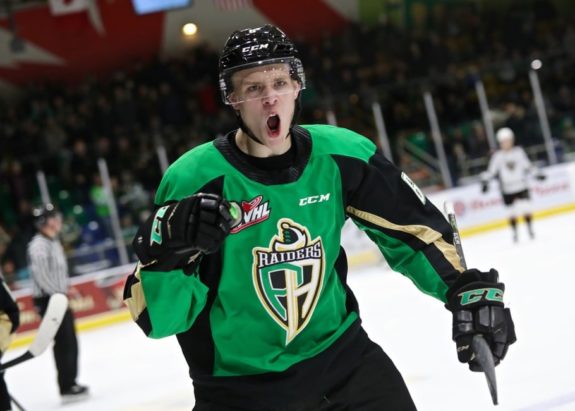
Some of those 19 may seem like a stretch for the top 20, but there are at least a dozen defencemen that could — theoretically and realistically — be taken in the teens. I do suspect we’ll see half that many — a half-dozen. Six defencemen in the top 20, that can stand as my prediction, but I would be tempted to take the under on that betting line.
7) How far will Justin Barron fall?
I’m going to say not far — not out of the first round and perhaps not even out of the top 20. I could still see Barron going in that 15-20 range — in the later teens — despite so many public rankings dropping him from their top 31. Some have Barron outside the top 50, which speaks to how his stock has plummeted due to inactivity. He has been out of sight and out of mind for much of the draft year, getting surpassed and overtaken by all the risers, but NHL teams won’t forget what Barron is capable of at his best.
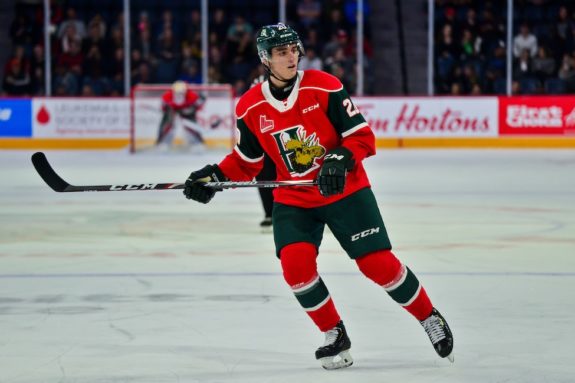
Barron entered the draft year as Drysdale’s biggest challenger to be the top defenceman in 2020. But he got off to a slow start on a bad team in the QMJHL before getting sidelined long term by a blood clot, which caused Barron to miss the World Juniors. He was expected to be a big part of Canada’s blue line at that tournament — based on a strong showing at the WJC Summer Showcase — and that could have thrust Barron back into the top-10 conversation. However, he is healthy again now and still belongs in that top-20 discussion.
RELATED: 6 Divisive Prospects for THW Scouts
8) How far will Hendrix Lapierre fall?
This one is more difficult to answer because concussions can scare off a lot of teams. Lapierre has top-15 talent — arguably top 10 based on his breakout at the Hlinka Gretzky Cup to begin the draft year — but the concussions are a serious cause for concern, especially since he didn’t return before the season was paused. He hasn’t played since November and had been struggling prior to getting concussed, with only two goals through 19 games in the QMJHL.

It is entirely possible that Lapierre could fall out of the top 20. But out of the first round entirely — out of the top 31? I can’t see it. He is too talented to be passed over that many times, especially with a number of teams having multiple picks in the first round. Somebody will take a chance on Lapierre in the 21-31 range and it might be Anaheim with Boston’s pick if he happens to fall that far. Just a hunch. Ottawa (via the Islanders) and New Jersey (via Vancouver) are also possibilities since those would be their third selections within the top 31.
9) How far will Daemon Hunt fall?
Hunt has also been out of sight and out of mind — suffering a freak injury when a skate blade severely sliced his arm — but he had recovered and returned with four assists over five games before the season was stopped (finishing with 15 assists but no goals in his draft year). Hunt was one of the prospects that really could have boomed at the under-18 worlds and emerged as a riser towards the first round. But he needed that showcase and needed a standout performance on that stage to have a legitimate chance of cracking the top 31.
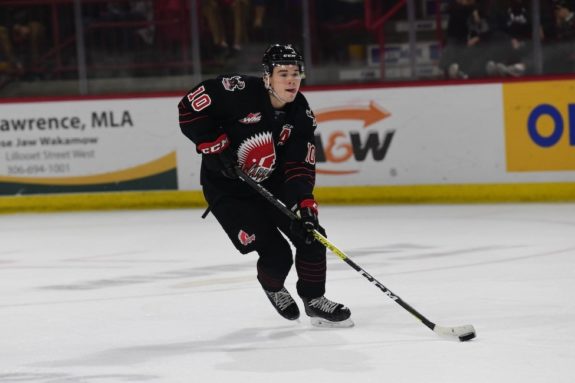
The top 50, however, remains a possibility. Hunt will be taken in the top 100 and likely in the top 75 based on his upside. Whether he slides out of the top 62 — out of the second round — is the real question. I think that is a 50-50 scenario as of now. If there is a draft combine and Hunt hits it out of the park there — both in the interview portion as well as the physical testing — then I could see him climbing back into the second round and perhaps the top 50. If the combine is cancelled and everything is status quo, I foresee Hunt slipping to the third round in that 63-75 range where he’d be a potential steal going forward.
10) How many Germans will go in the first round?
This answer could be one, two or three. Yes, three Germans could go in the first round and will almost certainly be gone in the top 50. Those being the aforementioned Stutzle and fellow forwards J.J. Peterka (23) and Lukas Reichel (40). Stutzle is a special talent sure to be taken in the top five, with the potential to overtake Leon Draisaitl as the highest drafted German — Draisaitl went third overall in 2014. There is a decent chance that Stutzle matches Draisaitl’s draft position. Peterka played his way into the first-round mix at the World Juniors and Reichel plays a very pro game that should translate well to North America — and to the NHL, perhaps sooner than later, which makes him another candidate for the top 31.

If Pittsburgh hadn’t traded their first-round pick to Minnesota in the Jason Zucker deal, I could have seen Reichel in a Penguins jersey. But San Jose acquired Tampa Bay’s pick and St. Louis has taken a German in the first round before (Dominik Bokk, 25th overall in 2018), so both those teams could be eyeing Peterka and Reichel in that 21-31 range. Edmonton could have interest too, providing Draisaitl with a German wingman. This is going to be a fascinating draft for Germany to wrap up an unbelievable hockey year for that country, with Draisaitl leading the NHL in scoring and now the favourite for the Hart Trophy as league MVP. That prediction is easy — Draisaitl for the Hart — but how many Germans will go in the first round in 2020? I’ll stick with my rankings and say two, Stutzle and Peterka, but I won’t be surprised if all three are selected in the top 31.
Outside the first round and beyond the big three, there could be a few more Germans taken in 2020 with flashy forward Florian Elias (205) and mobile defenceman Maximilian Glotzl (206) also in my rankings as potential later-round picks. Simon Gnyp is a similar defender on my radar as an overager, while a trio of former CHL imports also made an impression at the World Juniors in forwards Tim Fleischer, Taro Jentzsch and Yannik Valenti, along with current import Nino Kinder (WHL Winnipeg). That is 10 Germans of draft interest — an incredibly high number for that nation — and it could be as many as 15 counting first-time eligible forward Filip Reisnecker, who had some hype in his younger years, over-age forward Timo Bakos, who crossed over to USHL Sioux Falls en route to NCAA New Hampshire, over-age forward Jan Nijenhuis, who has offensive jam despite not yet scoring in the DEL, and over-age goaltenders Tobias Ancicka and Hendrik Hane, who are both undersized by NHL standards but still possess pro upside as puck-stoppers. That group, as a whole, is evidence that Germany is a burgeoning hockey country with a bright future in the game.
BONUS QUESTION
Who will win the draft lottery — aka the Lafreniere lottery?
This is the billion-dollar question to be answered by a lottery ball, thus determining Lafreniere’s future playing home. The Detroit Red Wings have the best odds as the worst team by far this season, but the Ottawa Senators have two lottery balls with the second- and third-best odds (the latter courtesy San Jose). The New Jersey Devils have been lucky in the lottery — winning twice to land Jack Hughes (2019) and Nico Hischier (2017) as first overall picks — and will also have two balls, though their second from Arizona is top-three protected and New Jersey’s own pick has the sixth-best odds assuming the regular season isn’t completed. The Los Angles Kings and Anaheim Ducks have the fourth- and fifth-best odds, respectively, with Buffalo, Montreal and Chicago rounding out the top 10.
The Montreal Canadiens are supposed to host this year’s draft but might lose that opportunity, so winning the Lafreniere lottery would be quite the consolation prize. That would be the perfect fit, with Lafreniere becoming a Francophone face of the franchise for the Habs. Ottawa’s fan base also deserves a superstar to build around, with the potential for a dynasty there given the addition of Lafreniere. I could totally see Lafreniere thriving under Steve Yzerman’s mentorship in Detroit, so that would be another welcome winner. Chicago is another Original Six team and Lafreniere would bolster the Blackhawks back into contention. I can’t envision Lafreniere with either California club but can imagine how good L.A. would be with him joining the fold as the missing piece in the present. Buffalo is an afterthought of sorts when contemplating the possibilities. For me, the ideal suitors are Montreal, Ottawa and Detroit in that order. I’m not a Canadiens fan by any means, but I’d love to see them get Lafreniere.
Get the latest NHL Draft & Prospect rankings, news and analysis